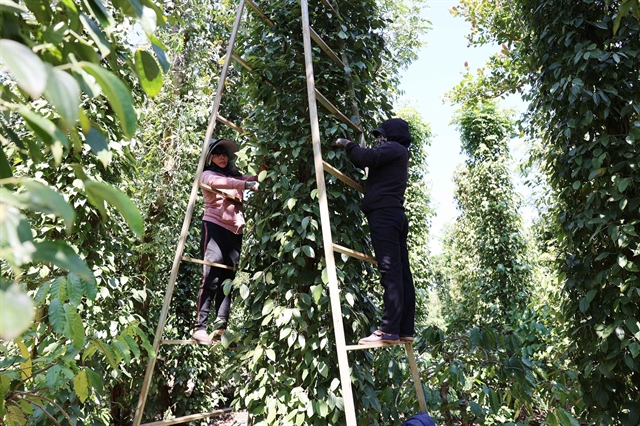.jpg) Economy
Economy

 |
| Farmers in Đắk Lắk Province harvest pepper. — VNA/VNS Photo Hoài Thu |
HCM CITY — With prices recovering after years of decline, pepper has regained its place among the country’s major export items and more farmers are increasing their investment in their pepper farms.
The price of pepper in major growing areas like the Tây Nguyên (Central Highlands) provinces of Đắk Lắk, Đắk Nông and Gia Lai and the southeastern provinces of Đồng Nai, Bình Phước and Bà Rịa - Vũng Tàu has been steadily increasing this year.
It has risen to VNĐ148,000-151,000 (US$6-6.2) per kilogramme, up from VNĐ65,000-67,000 just last year.
This has persuaded farmers in these provinces to invest more money in their pepper farms.
Huỳnh Thị Kim Phượng, a farmer in Hưng Phước Commune in Bình Phước Province’s Bù Đốp District, said her family has two hectares of pepper and used to harvest around two tonnes of the spice a year.
But with its price increasing this year, she has tended carefully to her farm and got an output of four tonnes.
It is grown to organic standards, and its output is purchased by Nedspice Processing Việt Nam Limited at VNĐ5,000 a kilogramme higher than the market price, she said.
Prices are forecast to increase to more than VNĐ160,000 ($6.5) amid a global scarcity, according to Hoàng Thị Liên, chairwoman of the Việt Nam Pepper and Spice Association.
Outputs in Brazil and Việt Nam, the worlds’ two largest pepper producers, have declined because of the impacts of the El Niño phenomenon, which cause drought.
Other pepper producing countries such as Indonesia, India, Malaysia and Sri Lanka have also seen outputs decline.
The output in the next three to five years would not meet demand, according to the association.
Việt Nam exported 145,330 tonnes of black pepper and 19,027 tonnes of white pepper for a total of 164,357 tonnes worth $764 million in the first seven months of the year.
The exports were down 2.2 per cent year-on-year in volume terms but fetched 40.8 per cent more money.
The average prices of the black and white varieties were $4,568 and $6,195 a tonne, up 32.7 per cent and 25 per cent respectively year-on-year.
The US was the largest export market, followed by Germany, the UAE, India, and China.
The association estimates exports to again be worth $1 billion this year.
The pepper growing area in the country has declined by half from its peak because of expanding durian and coffee cultivation, according to the association.
New additions are not large and they mostly intercrop pepper with coffee.
Output this year is estimated at 170,000 tonnes, down 10 per cent from last year, it added. – VNS




